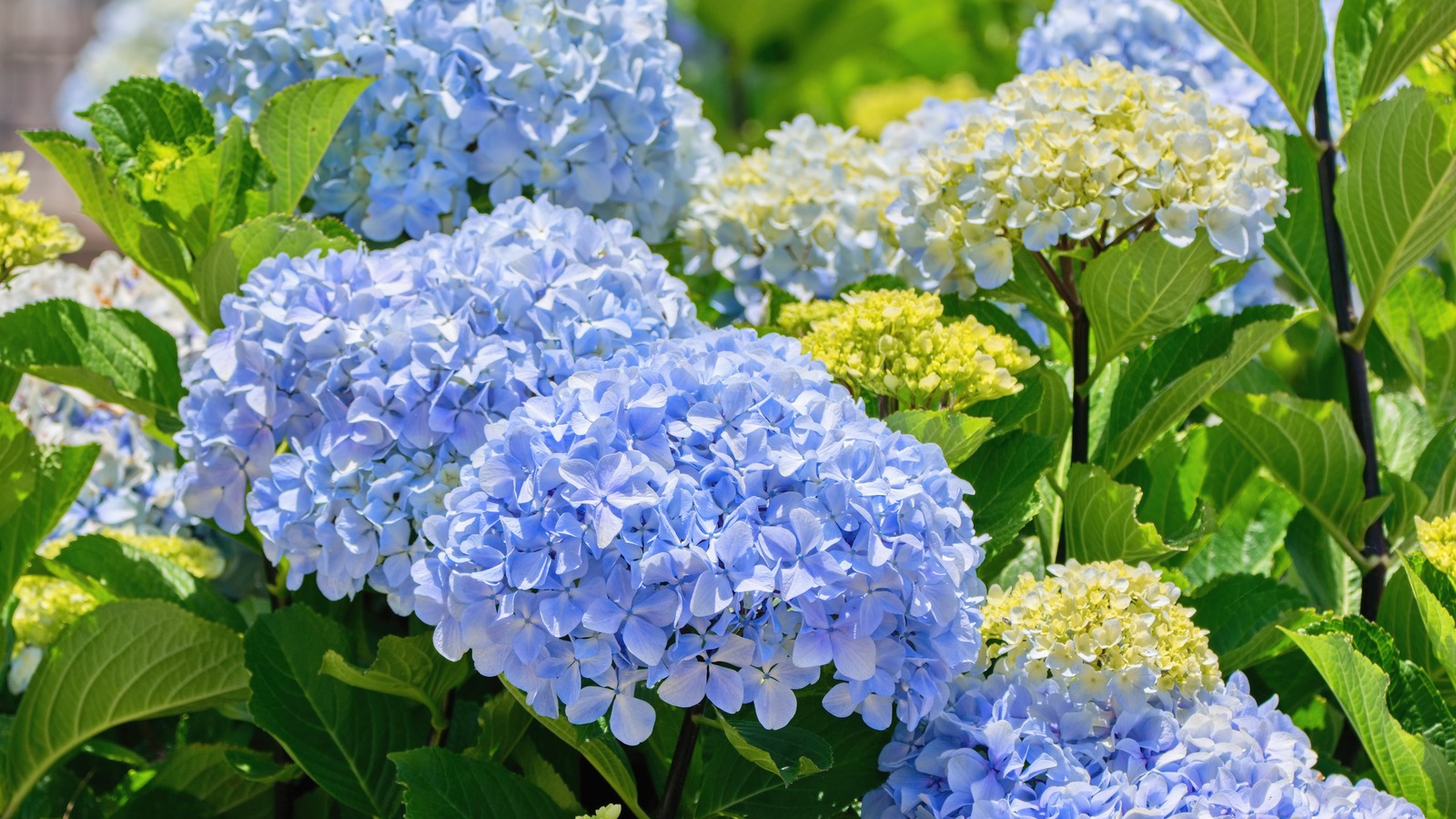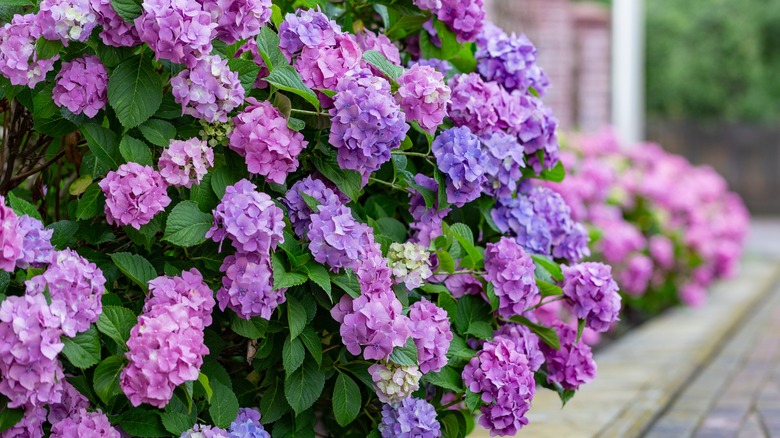Clay soil is a common challenge that many gardeners face when it comes to growing plants. Its heavy texture and moisture-retaining properties can make it difficult for some foliage to thrive. However, the hydrangea is perfect for picky clay substrate because it can tolerate heavy, moisture-rich soils.
Hydrangeas may even do better in clay soil without any other changes being made, but in the long run, changing the soil can help this hardy flower and others do better. Its moisture-retaining properties ensure that hydrangeas receive enough water, which reduces the need for frequent thirst quenching. There are some things you can do along the way to help your hydrangeas and some plants that are very picky grow well. Consider creating a raised bed to improve drainage and prevent waterlogging of the roots. In clay soil that is packed down, digging a wide area that is bigger than the root ball gives the roots plenty of room to grow. Tilling and aerating the soil can also improve its quality by making it less dense, which lets water drain more easily. Lastly, applying a layer of mulch after tilling helps protect the soil from erosion and compaction.
Hydrangeas are gorgeous blooming shrubs that add vibrant pops of color to any garden. With their large showy flowers ranging from crisp whites to deep blues and purples it’s no wonder they are a favorite for many gardeners. However, successfully growing these beauties can be tricky, especially when dealing with stubborn clay soil.
As a gardener myself, I know firsthand how challenging clay soil can be. The heavy, dense texture tends to get waterlogged while also compressing roots. Needless to say, many plants don’t thrive in these conditions. But the good news is hydrangeas are an exception!
In this article, I’ll share tips and techniques I’ve learned for successfully growing vibrant hydrangeas even in pesky clay soil. Read on to learn how to prepare clay soil for hydrangeas, proper planting techniques, watering and fertilizing best practices, and more
A Bit About Hydrangeas
Let’s start with a quick overview of these incredible bloomers. There are over 75 species of hydrangeas, though the most popular varieties grown in home gardens are:
-
Bigleaf hydrangeas – Known for their large, globe-shaped flower heads. Most common types are Endless Summer, Nikko Blue, and Pinky Winky.
-
Panicle hydrangeas – Feature big, conical-shaped blooms. Popular varieties include Limelight and Quick Fire.
-
Smooth hydrangeas – Also called Annabelle hydrangeas. Known for round, white blooms.
The key fact about smooth hydrangeas is they are native to North America and are naturally accustomed to growing in dense, clay-based soils. This makes them an ideal choice if you’re battling heavy clay in your garden.
Preparing Clay Soil for Planting
While smooth hydrangeas can tolerate clay soil, it’s still best to prepare the growing area to give them the best chance of thriving. Here are some tips:
-
Add compost – Incorporate several inches of high-quality compost into the soil. This will lighten the heavy clay texture and improve drainage.
-
Create raised beds – Building up raised garden beds can improve drainage in clay soil. Add amended soil to the beds.
-
Double dig – Dig down deep, at least 12 inches, and turn the soil to loosen compacted clay. Then backfill with compost.
-
Aerate the soil – Use an aeration tool to poke holes and allow air circulation in dense clay.
-
Mulch well – Cover beds with 2-3 inches of organic mulch like pine bark. This prevents compaction.
-
Test soil pH – Hydrangeas prefer slightly acidic soil with a pH between 5.2-5.5. Add sulfur to lower pH if needed.
How to Plant Hydrangeas in Clay Soil
When it’s time to plant your hydrangeas, follow these tips to give them the best start:
- Dig a hole 2x the width of the root ball
- Loosen the soil in the hole and mix in compost
- Place the plant in the hole, positioning the crown right at soil level
- Backfill the hole with your amended soil mix
- Water thoroughly to settle the soil around the roots
- Mulch well, leaving space between mulch and plant crown
Additionally, provide some shade for newly planted hydrangeas for the first 1-2 months to prevent transplant shock.
Watering Needs in Clay Soil
The water retention properties of clay soil can be a blessing and a curse when it comes to hydrangeas. Follow these guidelines for best results:
- Check soil moisture levels frequently, about 1-2 inches below surface
- Water thoroughly only when top inch of soil is dry
- Provide 1-3 gallons per shrub, depending on size
- Avoid overwatering! Clay absorbs but doesn’t drain well.
- Reduce watering frequency after first year
- Mulch to conserve moisture and reduce water needs
The key is providing enough water for moisture-loving hydrangeas, while not oversaturating the soil. Proper mulching and soil preparation will help find this balance.
Fertilizing Clay Soil Hydrangeas
Hydrangeas thrive when fed a balanced, slow-release fertilizer high in phosphorus. Look for formulas like 10-10-10 or 20-20-20. Spread fertilizer around the plant, following package directions.
These tips will maximize benefits:
- Fertilize first in early spring, to support new growth
- Fertilize again in late spring/early summer to support blooms
- Slow-release formulas are ideal to prevent nutrient runoff
- Avoid late season fertilizing which can spur harmful new growth
With proper, timed fertilization, your hydrangeas will reward you with vigorous blooms even in clay soil conditions.
Mulching Hydrangeas in Clay Soil
Aside from water conservation, mulching offers other benefits for hydrangeas in clay soil:
- Helps regulate soil temperatures
- Prevents overheating of roots in summer
- Retains warmth in soil during cooler seasons
- Reduces compaction and improves aeration
Spread 2-3 inches of organic mulch like pine bark or wood chips around hydrangeas. Leave a 1 inch space between mulch and plant crown to prevent rotting. Replenish mulch annually.
Tending to Hydrangeas Year-Round
Caring for your hydrangeas goes beyond the main growing season. Follow these tips all year:
- Prune in late winter, removing dead stems and spent blooms
- Leave pruning until spring on varieties that bloom on old wood
- Provide winter protection like burlap wrappings in very cold climates
- Water occasionally during winter dry spells
- Remove old mulch and fertilize in early spring
- Monitor for pests like aphids through the growing season
- Enjoy the blooms! Deadhead to encourage more flowering
With the right care, your hydrangeas can thrive year after year, even in the trickiest clay soil.
Choosing the Best Hydrangeas for Clay Soil
While all hydrangeas can grow in clay with proper amendments, these varieties are best suited for heavy soil:
-
Smooth hydrangeas – Tolerate heavy clay naturally. White Annabelle variety is easiest.
-
Panicle hydrangeas – Limelight and Quick Fire varieties do well in clay.
-
Oakleaf hydrangeas – Named for their unique foliage. Do well in clay.
-
Climbing hydrangeas – Grow well on clay slopes and banks.
When in doubt, opt for smooth hydrangeas, the natural choice for stubborn clay soil!
Be Patient With Hydrangeas in Clay Soil
One final tip – be patient with your hydrangeas, especially in their first year after planting. It can take some time for their roots to adapt to heavy clay soil conditions. But with proper preparation and care, these showy bloomers can thrive in clay.
The effort is well worth it when you gaze upon vibrant, cheery hydrangea flowers lighting up your garden with color. I hope these tips help you succeed in growing hydrangeas, even with the challenge of heavy clay soil. Let those flowers bloom!

How to work with clay soil

Before you plant hydrangeas in clay soil that is known to be tricky, you need to make a hole twice as big as the root ball. This will allow the roots to easily penetrate the clay soil and establish a strong foundation. When amending the soil, remember that a little goes a long way. To keep the soil-to-clay ratio healthy and stop too much water from building up at the roots, don’t add more organic matter than 5% to 10% of the total. To boost the nutrients and clay soil structure, try using compost from healthy trees. This will improve soil quality over time, which will benefit your hydrangeas in the long run.
For best results when planting hydrangeas in clay soil, put them somewhere sunny. This is because clay soil is good at keeping water in. Shade your hydrangea for a month or two after planting to help the roots grow and prevent transplant shock. The color of hydrangea flowers also depends on the soils acidity level. Alkaline soil typically yields lovely pink flowers, while neutral soil enriched with organic matter can produce purple blooms. If youre looking for blue blooms, youll want your soil to be acidic, so be prepared to mulch. Adding organic matter is the easiest, though lengthier, way to achieve acidic soil without the use of chemicals.
Mistakes Make Us Better Gardeners (a drowning hydrangea) | Clay Soil Woes
FAQ
What are the best plants to grow in clay soil?
What type of soil do hydrangeas grow best in?
What bush grows well in clay soil?
|
Arborvitae
|
Aronia
|
Buttonbush
|
|
Cotoneaster
|
Dogwood
|
Diervilla
|
|
Flowering Quince
|
Forsythia
|
Honeysuckle
|
|
Lilac (well drained clay only)
|
Ninebark
|
Potentilla
|
|
Rose of Sharon
|
Smooth hydrangea (well drained clay only)
|
Spirea
|
Can hydrangeas grow in clay soil?
In short, you can grow hydrangeas even in clay soil. However, if you want a thriving plant, you may have to make some amendments. For instance, add organic matter (to make it richer in nutrients) and mulch to improve drainage and moisture (especially if you live in a hot region). Related Article: When to Plant Hydrangeas?
How do you grow Hydrangeas in a garden?
Amend the soil with lots of organic matter. Promote drainage by using raised beds, adding mulch, and aerating the soil. You can also simplify the struggle by using the ideal hydrangea variety. Pick hydrangeas that do well in clay, such as Smooth Hydrangeas. Clay soil can be the enemy of the gardener.
When should I plant Hydrangeas in clay soil?
The best time to plant hydrangeas in clay soil is in early spring or fall when the weather is cooler. This allows the plants to establish their roots before the heat of summer or the cold of winter. Avoid planting during extreme weather conditions. How deep should I plant hydrangeas in clay soil?
What kind of soil do hydrangeas like?
Generally, hydrangeas are relatively tolerant and not too picky about soil. Pick one of the subtypes that do well in clay, or be sure to prepare the soil well first to encourage drainage. In this article, we’ll cover the best kind of soil for hydrangeas.
Do hydrangeas grow well in shade?
To support your hydrangeas root development and reduce transplant shock, shade the plant for a month or two after planting. The color of hydrangea flowers also depends on the soil’s acidity level. Alkaline soil typically yields lovely pink flowers, while neutral soil enriched with organic matter can produce purple blooms.
Can hydrangeas grow in sand?
However, do note that very sandy soil is not ideal for Hydrangeas because it does not hold onto enough of the moisture that Hydrangeas need-when it comes to sand, balance is necessary. If your soil is too sandy to be ideal, you have two options.
- A Complete Guide to Caring for Yuki Cherry Blossom Shrub - January 23, 2025
- Identifying Red Hot Poker Seeds: What to Look For When Harvesting Torch Lily Pods - January 23, 2025
- A Complete Guide to Harvesting Evening Primrose Seeds - January 23, 2025
